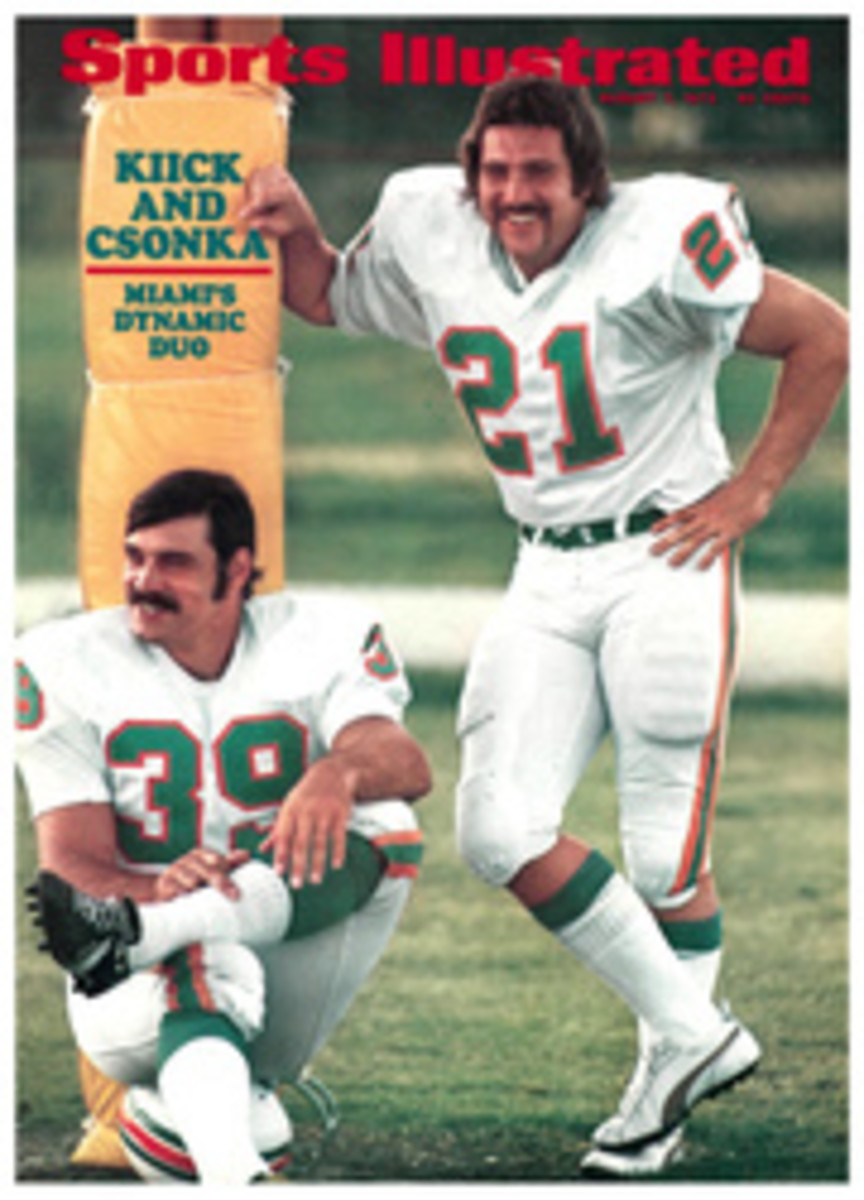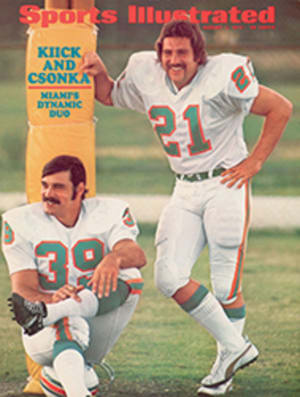
SCORECARD
MR. FERRIS MAKES A PUN
Word went out last week that the International Amateur Athletic Federation had banned for Olympic use the type of pole Bob Seagren used to make his world-record vault of 18'5¾". And not just Seagren would be handicapped. So would the two other U.S. vaulters chosen for the Munich Games.
"New poles have recently been developed using new materials or different methods of manufacture," an official IAAF statement said. "These poles enable a vaulter with a given body weight and strength to use a lighter pole than hitherto."
Conceding that such poles do not contravene existing IAAF rules, the statement nonetheless held that "the use of a new, improved type of pole could confer an advantage on the limited number of athletes who have had the pole in their possession for a long enough period to become accustomed to its special properties. The IAAF has therefore decided that for a pole to be permitted for use at the 1972 Olympic Games, it must have been available to all athletes through normal supply channels since August 1971."
Whereupon George Moore, maker of the pole, set a new record for hitting ceilings.
"It's a production pole," he said, "not a special pole produced only for Seagren. We have between 350 and 400 of these poles in use throughout the world by all the world-class vaulters....
"There are no new materials in these poles. They are 100% fiber glass. The only difference is that the glass has greater strength-to-weight ratio. This enables us to produce a pole that is lighter and smaller in diameter."
If further confusion is needed, consider the version of Dan Ferris, U.S. member of the IAAF council, who said he took part in a mail vote of the council in which the question was: "Should carbon fibers be permitted in new vaulting poles for Olympic competition?" Along with others in the council, he voted "No." The 83-year-old Ferris said he never did vote against the pole Seagren uses, since it contains no carbon. Nor does another similar pole.
"Those people were barking up the wrong pole," he said. "I sent a cablegram to the Federation explaining that those two poles were not suspect.
"The whole thing," he concluded, "is up in the air." Then he chuckled.
FOURSOME AT BURNING TREE
Politics makes strange golf opponents.
Last week, chatting with the press after giving out a few news tidbits, President Nixon let drop that he would play next day with Secretary of State William P. Rogers at Burning Tree Club. He quipped about Vice-President Agnew's game and, responding in kind, a reporter asked jokingly if he would play with George Meany, president of the AFL-CIO. The labor organization had routinely endorsed every Democratic presidential candidate since its formation but this year refused to back Senator George McGovern, largely because of Meany's antipathy. Withholding the endorsement was quite a plus for the Nixon team.
The President's response was noncommittal. He remarked pleasantly that he wouldn't bet against Meany "from within 100 yards of the pin."
Next afternoon the President and Rogers arrived at Burning Tree and there, by George, was George Meany, getting set to play with George Shultz, Treasury Secretary.
"The President invited them to join him," a White House aide explained.
Newsmen were not permitted to watch and no one would give out details about the match, but one observer reported that the President, who had not played golf for a year, showed few effects of the layoff. "His backswing has shortened, which comes with age," another said, "but he still has a good short game."
"We won the first nine," Shultz is reported to have said. "Then, for the second nine, the President changed our handicap and they won." No one would say what the scores were.
But in the great game of politics the President is out of sight.
MARKET TIP
It might be considered a reasonable assumption that if a baseball team orders slippery-elm throat lozenges in quantity, some pitcher on that team must be throwing spitballs. Slippery elm, while also good for a scratchy throat, is highly regarded as the very finest ingredient to use in preparing the ideal spitter. Pure spit alone is not nearly as good.
Two baseball clubs, the Los Angeles Dodgers and the Chicago Cubs have been ordering their slippery-elm throat lozenges in quantity from the Henry Thayer Company of Cambridge, Mass., which makes them from the bark of the slippery elm tree. In other years, other clubs have ordered the lozenges but says Irving H. Chase, president of the company, "We haven't had too many orders this year, just from the Dodgers and Cubs.
"I don't know which players use the lozenges," he said. "The trainers order them and we ship directly to them."
There is a continuing move, backed by most umpires, to legalize the spitter but it will take seven votes of the nine-man playing rules committee to restore the pitch to the high moral plane that prevails in baseball.
At next winter's meeting of the committee, Bobby Bragan, one of its members, will introduce legislation to anoint, if that is the word, the spitball. Bragan is president of the Class AA Texas League and if he is successful keep an eye on Henry Thayer Company stock.
THE WONDERFUL WORLD OF KENNETH
Complaints from neighbors in Redwood City, Calif. forced Dr. E. H. Rentschler to give up his kangaroo and peacocks. Now he has to dispose of his two pet llamas. They had taken to spitting at a neighbor, whose name just happens to be Kenneth Disney.
YOU COULD TRY WHEATIES
Magic potions to improve athletic performance are nothing new. In the very early Olympic Games the Greeks were suspected of using certain mushrooms to give themselves a bit of an edge.
The practice has continued. In 1865 there was suspected doping among Amsterdam canal swimmers. In the six-day bicycle races of 1879 there was dark suspicion that competitors were not above using nitroglycerine or even sugar cubes dipped in ether.
Whatever athletes did or are doing to boost performance with drugs, says Dr. Daniel F. Hanley, chairman of the U.S. Olympic Medical and Training Services committee, writing in Modern Medicine, they are deluding themselves. In his 30 years of associating with athletes and studying their reactions to drugs, he has yet to find a proven case of superiority arising out of the use of dope.
"Since 1967," he wrote, "several programs of dope testing have been held at world and national competitions. Each program has documented the fact that there is no wonder drug."
A cited example is the world weight-lifting championships in Columbus, Ohio in September 1970. Each athlete who won first, second or third in each class was required thereafter to furnish a urine specimen. Eight of the winners tested positive for amphetamines. They were disqualified.
But then, aware that dope tests were being conducted, all other competitors showed negative.
More records were broken in the final undoped half of the competition than in the first.
Dr. Hanley, who is physician at Maine's Bowdoin College, also is low on steroids as a means of enhancing performance, though they are taken commonly as a means of increasing weight and muscle.
"The companion fable that increased weight means increased strength also is unproved," he holds. "Anabolic steroids do increase weight in normal young adults but the weight gain probably represents mostly fluid retention.
"From a practical point of view, the world record in the shotput has stood since 1967, in spite of the hundreds of young men who have absorbed more steroids than reasonable men would believe possible."
For excellence in sport, Dr. Hanley holds, there is no easy way. Which may be all for the best.
DEAR OLD RUTGERS, ALAS
For 18 years now the National Football Foundation has been collecting money for what, it was hoped, would one day be a College Football Hall of Fame to be established on the campus of New Jersey's Rutgers University, where the first college football game was played in 1869. When ex-Senator George Murphy accepted the presidency of the foundation last year he did so with a firm promise of fealty to the Rutgers tradition.
Last week the foundation chose to abandon the Rutgers site and, instead, settled for a six-floor brownstone house in Manhattan, where stickball is the more appropriate game. Instead of spending an anticipated $5.5 million for the Rutgers campus site, it chose to put up a reported $1 million for a building on East 80th Street.
The athletes, coaches, writers and other sports figures who voted for the Rutgers locale 25 years ago were not polled about the decision. Rutgers, which had housed the temporary headquarters of the Hall of Fame rent-free, had paid some staff salaries and had donated a 9.8-acre plot with a 99-year lease at $1 a year, was left waiting at the church and properly aghast.
"I don't think it's particularly good faith," said Sonny Werblin, who in 1965 generously donated the proceeds of a Jets exhibition at Rutgers Stadium to the building fund. "If the Professional Hall of Fame is at Canton, Ohio, where pro football started, the Collegiate Hall of Fame belongs at Rutgers."
Of course it does. Will anyone really care to go to East 80th Street to see Red Grange's helmet?
BOMBS AND BLOOD
The man who did more than any other to bring The Bomb to popularity in professional football wishes that the game's legislators would outlaw the zone defense and thus restore the "quick six points."
John Unitas, the Baltimore Colts' 39-year-old quarterback, thinks that the zone probably will be outlawed eventually, but too late for him.
"Fans come out to see the exciting play and an offense against the zone has to be methodical, taking the short stuff and forgetting about the long pass," he said.
"They outlaw the zone defense in the Pro Bowl. All the coverages are man-for-man and the games don't get out of hand as some thought they would. I think most fans would like to see games where the final score is 28-24 instead of 10-7."
Some critics have suggested that Unitas does not throw The Bomb often these days because his aging arm isn't up to it, but Unitas begs to differ. "It just can't be done anymore," he said. "You know I would do it if there were even a remote chance of success, but there isn't."
Whatever may be said of the old man's arm, there is one area in which he excels physically. John Brinser of the University Community Hospital, just off the University of South Florida campus, was studying blood tests given the Colts. One sample commanded his special attention.
"It's a perfect textbook picture of a blood analysis," Brinser told Trainer Ed Block. "It's the best blood."
It belonged to you know who, that 39-year-old thoroughbred, Johnny Unitas.
THEY SAID IT
•Jerry West, Los Angeles Laker star, on Wilt Chamberlain's million-dollar mansion: "Someday when he is ready to sell, I'm sure a madam will buy it."
•Chuck Thorpe, rookie PGA golfer, asked what he likes to eat: "I like steak and good food like that, but mostly steak. If you eat hot dogs, you play like one. If you eat hamburger, you play like one—flat."
ILLUSTRATION

